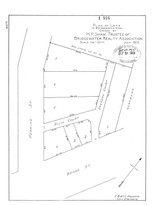Business Profile: 136 Broad Street
- James Walsh
- May 21, 2020
- 2 min read
In the last post about the subdivision of Nahum Stetson's estate, we focused on the residences that line Stetson Street on the southern part of the lot. Today, let's look at the northeast corner, bounded by Broad Street, Perkins Street, and the railroad tracks. In 1903, this was still a single private home:

By 1913, Harlan P. Shaw had purchased the land, demolished the home, and subdivided the lot into seven parcels connected by Stetson Court and Ellis Court. Though no longer listed on the street map, Stetson and Ellis Courts still exist as narrow alleys between the lots.
Shaw made Lot 1 (136 Broad Street) unusually long and narrow. He probably expected that whoever bought it would build a freight warehouse or loading dock to take advantage of its railroad frontage. Demetreos Athanasion had a different idea; he used the long lot to build a bowling alley and pool hall.
Athanasion converted the bowling alley to a store called "U-Save Market" in the 1920s, and then sold the building to Bronislawa Woronicz in 1935. Woronicz owned several lots on Crapo, Broad, and Perkins Streets, and her children included Boston College Hall of Famer Henry Woronicz.
Woronicz sold the building in 1945 to Paul Palatroni, Etra Pratti, Ernest Valeri, Mario and Frank Ferioli, and Primo Resmini, who opened the Quality Lunch restaurant at the site. Surrounded on all sides by factories and industry, the restaurant was a hot spot for workers on their lunch breaks.
Ralph Costello bought the restaurant in 1950 and reopened it as his Italian Canteen. Gradually, the workers' housing on Spring Street was replaced with student apartments, bringing a steady stream of customers even as industry faded in the area. Crispi Falconeiri bought the restaurant in the 1980s, and Crispi's has remained in the Falconeiri family ever since.
Comparing the two photos of Costello's, one can see how the original clapboard and windows were later replaced with stone. 136 Broad Street's façade has changed over the years, but it maintains its original footprint as well as a lighted sign dating to at least the 1960s.











